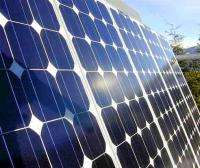October 5, 2012 report
New theoretical technique applied to properties of ultrathin solar cells

(Phys.org)—As solar cell technology matures, researchers continue to look for ways to develop ever-thinner technology to reduce material costs. Such technology also reduces the distance electrons and holes, loosened by light, have to travel—resulting in less loss when they recombine. However, using traditional materials means that less light is absorbed. As such, recent efforts have focused on using cells with nanometer-sized structures as they allow for the number of light interactions to be increased. However, researchers have been limited in their ability to predict the properties of solar cells when using such materials. Now researchers from the University of California, Berkeley, have developed a theoretical technique for calculating such properties. As they write in their paper published in Physical Review Letters, the technique lends itself to possible use in simulation tools.
To start, the team describes the connection in solar cell technology between two states: thermal equilibrium and one where a disturbance has occurred. When in equilibrium, they say, many processes are occurring, most specifically those involving absorbing and emitting photons. To calculate a cell's efficiency, its photocurrent (the rate of creation of electron-hole pairings) and recombination current (the rate of recombining of electron-hole pairs in making photons) must be known.
In looking at the recombination events, the team found they were able to use the fluctuation-dissipation theorem (to connect the equilibrium state to the one where a small disturbance has occurred) to calculate the power involved as it applies to thermodynamic properties, e.g. chemical potential and temperature. Such calculations allowed them to then generate parameters for voltage, current, and efficiency for ultrathin solar cells based on an idealized cell made of gallium arsenide on a gold substrate. Using these parameters, the team then measured four emission channels of the idealized cell—two polarizations each of light that is emitted back into the air or the gold substrate. In so doing, the researchers were able to calculate the overall efficiency of the solar cell in advance of its actual construction. Such a discovery leads to the possibility of creating a simulator capable of providing such statistics to build new, more efficient solar cells based on ultrathin materials.
In testing their calculations, the team found that while nanometer-sized structures do allow for taking advantage of near-field optical effects, their properties can also affect the rate at which electrons and holes combine, impacting overall efficiency. Consequently, this impact must be taken into consideration when developing real-world applications to prevent building in a negative efficiency factor.
More information: Near-Field Electromagnetic Theory for Thin Solar Cells, Phys. Rev. Lett. 109, 138701 (2012) DOI: 10.1103/PhysRevLett.109.138701
Abstract
Current methods for evaluating solar cell efficiencies cannot be applied to low-dimensional structures where phenomena from the realm of near-field optics prevail. We present a theoretical approach to analyze solar cell performance by allowing rigorous electromagnetic calculations of the emission rate using the fluctuation-dissipation theorem. Our approach shows the direct quantification of the voltage, current, and efficiency of low-dimensional solar cells. This approach is demonstrated by calculating the voltage and the efficiency of a GaAs slab solar cell for thicknesses from several microns down to a few nanometers. This example highlights the ability of the proposed approach to capture the role of optical near-field effects in solar cell performance.
Journal information: Physical Review Letters
© 2012 Phys.org

















